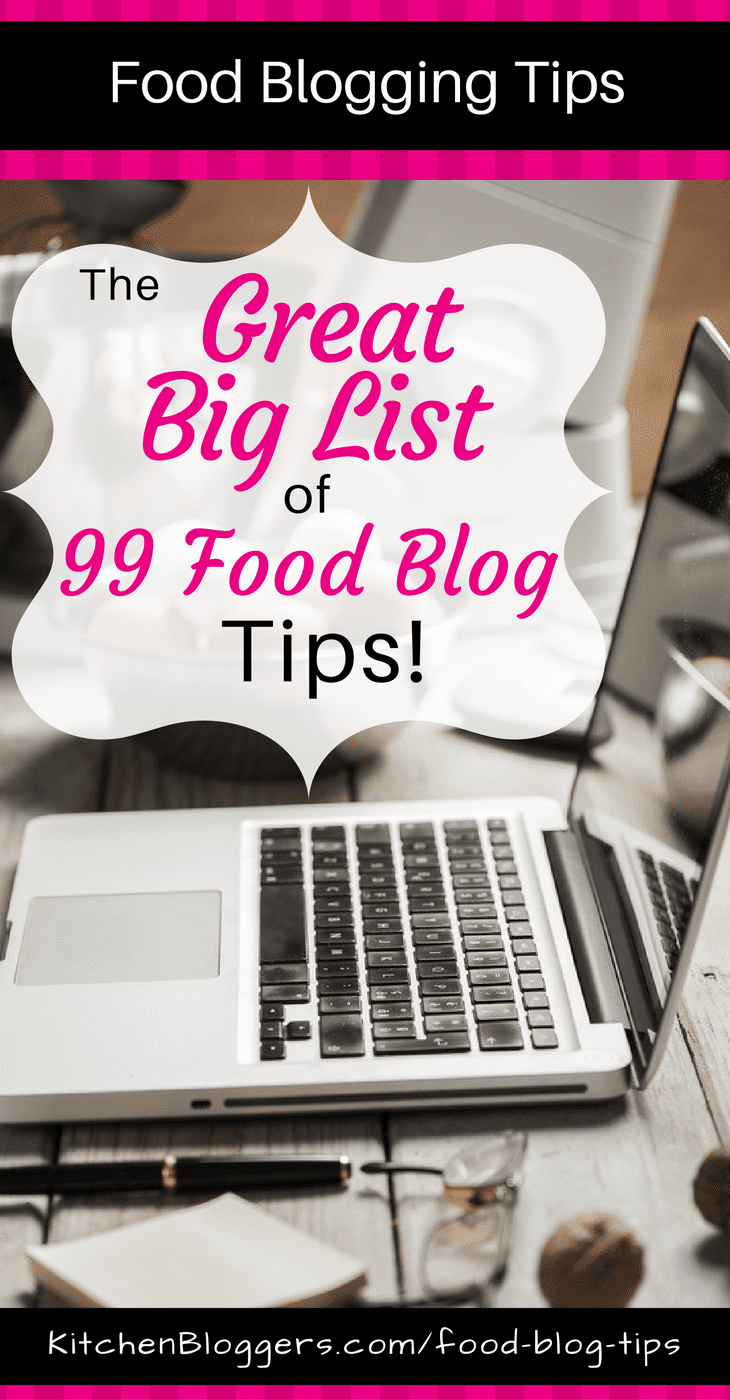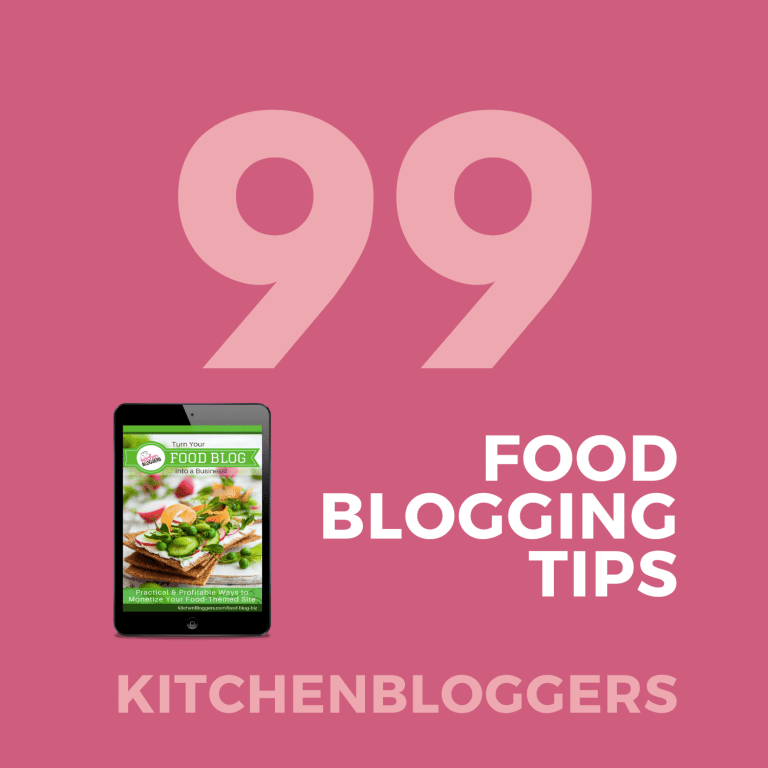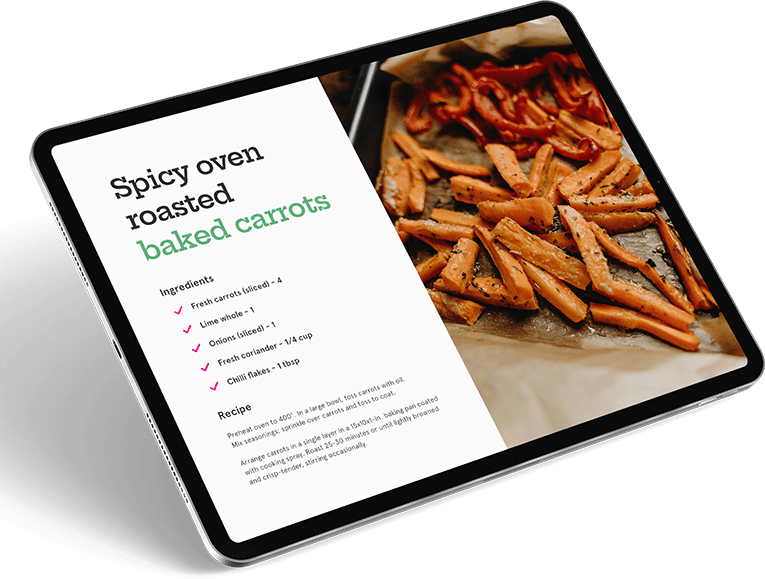If you’ve ever wanted a list of 99 random, but very useful, food blogging tips, here ya go!

- Use your ingredients to tell the story: Succulent peppers for hot summers, cucumber slices on crushed ice to refresh, etc…
- When photographing food, ask yourself: “What story do I want this to tell?” Make sure every prop supports the story.
- Be sure to use warm light when photographing food. Cold light will make your dish look lifeless and unappealing.
- Use close ups to make food feel actual size, emphasizing mouthwatering details such as the sparkle of sugar or a buttery flake.
- Combine details of your life with your dish or ingredients, when photographing food to go with a personal story.
- Adjectives should be used sparingly or they’ll seem overused. Limit the use of delicious, amazing, etc.
- Tell stories with the cooking process. A floury rolling pin on a dark counter with floury child fingerprints can say everything.
- Remember that ingredient lists are not under copyright: Processes containing personal details are, so you still can’t copy recipes.
- Use vintage props or old family photographs to help create a nostalgic mood and share a great food story.
- Reminder! If you provide links or blogrolls to outside sites on your food blog, do check occasionally to make sure these links are still valid.
- Use hashtags to encourage people to spread your story. For example: #WildBerryPicking; #ChristmasTreats.
- What will better help your story along? Photographs of the ingredients, the finished dish or the process?
- Decide your focus: The food, the plate or the props. Which one best tells your food story?
- Give your recipes descriptive, tempting names that add to the story. Then use them as a hashtag. (#BourbonBBQSauce, anyone?)
- To improve Google SEO in your food blog, so don’t forget to use relevant keywords
- Use local flowers or herbs in vases to add ambience to dishes containing those ingredients or representing an area.
- You don’t always have to put a flower in a vase or a cold drink in a glass. Just saying’…
- For whimsy, add garnishes such as lemon slices, dill sprigs or rock salt to fresh, uncooked ingredients such as just-caught fish.
- Create ambience with light, texture and props, when it comes to photographing foods. But always make sure these support your story.
- Check your assumptions, once in a while. Show your food photo to ten different people and ask: “What does that say to you?”
- If you want to photograph other people in photos, ask permission—and have them sign a model release.
- You can discreetly photograph other diners in a restaurant—if no part of them is personally identifiable e.g. you blur them or use a back view.
- Don’t stage. Present the people as well as the food. Let them be themselves – they’ll add authenticity to your food story.
- Always give credit generously. Showcase your food blog guests. Help them drive traffic to their site. They’ll return the favor.
- Food is about community: Never forget that, whether you’re taking about family food adventures or making blog marketing decisions.
- Tell food stories with texture: Rough grains and unpeeled veggies for rustic, farmhouse-kitchen recipes, delicate china for English teas, etc.
- If you are running an ethnic food blog, use location photos from that culture to add to the ambience.
- No matter how personal your food reminiscence, remember that readers should be able to instantly identify with it.
- Never give a slanted review to please a sponsor or someone who has given you a free sample or item.
- If you’re presenting snacks in photos, show them “on location”—i.e. with people actually eating them in situ.
- Try giving your blog a title and domain name that makes your blog’s focus crystal clear (e.g.: veggieschoolsnacks.com)
- Photograph people eating through a window for added ambience and an original perspective—from outside or in.
- Even if your focus is food, pay more than fleeting attention to your lighting. You can totally change the story with a sunbeam.
- Pay attention to the color of your food blog theme. Does it support your blog premise and focus—or does it do the opposite?
- For the most impact, make sure your blog tells a story. Who are you and what drives you to blog?
- Sum up your food blog posts in one word. Is there any sentence in the post out of harmony with that summary? If so, kill it!
- Steal the interior or graphic designer’s biggest secret: Use repetition of elements to make a food story or photo feel perfect.
- In everyday, real life, food gets burnt. Keep it real now and then and don’t sanitize all your food posts or photos!
- What’s your signature element in your blogging? A question of the day; a flower by a plate or…?
- Use comfort food posts, recipes and photos to make people feel like children again. Stir up those memories, and you’ve got fans.
- Show the packaging on foods, if it does a strong job of creating ambience. But ask, if you’re showing a trademark or logo.
- Instead of providing lengthy answers to email questions, post more informative content on your site. Everyone wins!
- Learn how to professionally answer reader emails. Keep it short and light and don’t ask questions, unless you want a penpal.
- Learn to think about overlooked elements: Add to your food photo stories with ice cubes, froth, garnish and so on.
- Food—and recipes—are made for sharing. Give common dishes your own signature twist to prompt shares for your blog.
- Get out to food events and show your actual community its own members…but ensure you get model releases.
- What do you remember about your mother cooking? Her apron? Her fingers or the sparkle of her ring? These are stories.
- Foodies are all artists. Never forget that, whether you are telling stories or dishing up practical ingredient lists.
- As a chef once famously said: “The single olive made the dish”. What is your “olive” for your food blog post?
- Either avoid jargon or use it only to add ambience. Either way, make sure your reader instinctively knows what you mean.
- Before photographing, pay attention to what you put your food in. Does it support or add to your story or ambience?
- Always make it easy for your food blog reader to find your recipes, use your recipes—and remember where to return.
- Use weather as a prop in food blog photos. E.g. storm clouds behind a glass of blood-red Merlot alone on a wet balcony rail.
- If you’re photographing a dish in a restaurant, keep it discreet. Don’t use a flash—it will kill both the food colors—and the ambience.
- Invest in different cutting boards, plates, cutlery, etc., so you can instantly support any story’s ambience with your food photos.
- Ensure your photo tips the scale towards inspiring your reader to actually try or share your recipe. What will it take?
- Remember that people share photos more than they share posts. Make sure each post on your food blog has one.
- Create and brand a YouTube channel for your food blog. Demonstrate cooking techniques, as well as recipes.
- Food blogs naturally lend themselves to blogrolls. Create goodwill to fellow bloggers and a great resource for your readers.
- Have a spam filter installed on your food blog (Akismet works). You don’t want your ratings or your readers insulted by spam.
- When you take your food photos for your blog, pay attention to the background. Is it contradicting your food statement or story?
- Add a “Takeaway Tip” to your blog posts. It’s an easy way to add the branding of repetition and you can be helpful and creative.
- What is one unique difference your food blog is known for? If you can’t answer that, no one else will be able to.
- Don’t always photograph fruits and veggies whole: Break open for a rustic look. Slice wafer-thin for elegance.
- No matter what type of food blog you run, people enjoy a trip down memory lane-particularly if they can relate. (S’mores, anybody?)
- Plan your blog posts and recipes in advance. Winging it makes for stressful blogging.
- Run fun, informal “contests on your food blog, such as caption contests for quirky photos.
- Are your headlines effective? Do they create curiosity or tell readers clearly it’s what they are looking for or evoke memories?
- Increase interaction by Tweeting your blog photo and link—and asking readers to describe in one word what it make them think of.
- Do you make full use of color in your food photos? Use cool colors when presenting summer dishes and hot colors to “warm up” winter.
- Always make sure your food blog stories are actually about your reader—even though the details are about you and your world.
- Remember that Instagram is a great place to share your food blog photos—and increase traffic to your stories and recipes
- Post a story about the most disastrous meal you ever prepared—and watch your shares go up. People love a good disaster story!
- Leave tweets unfinished to make people click to read more. “This collection of vegetables sure made me…”
- Answer reader questions in your blog comments section or tweets. This is the best way to turn visitors into subscribers.
- A food blog should be like the best sort of party: Introduce your readers to guests (chefs, other bloggers, etc.) they’ll want to meet!
- If you always post photos in color, consider switching it up to sepia or B&W, especially for nostalgic or historical posts.
- Test your recipes. It only takes one “fail” to lose a reader—and your food blog won’t be recommended or shared.
- Attend food events. Food expos, dinner parties, food competitions, local county fairs—get out in the world and liven up your blog.
- Don’t just keep an eye on other food blogs—keep up with top photography blogs to see what the pros are doing.
- Have a monetization plan for your content if you want to earn from your blog. What’s your plan?
- Dish turn out badly, but no time to remake it for a photo? Try photographing your place setting or ingredients instead.
- Food storytelling is especially important because food is what has connected people and created communities for thousands of years.
- If a reader enjoys your food story, she has shared a meal experience with you. She now feels like she knows you.
- Make sure your food photos will also look good on a mobile screen.
- What to do with people who email and demand entire cooking lessons: Create a course and invite all your readers to join.
- Put a FAQ or Glossary page on your food blog site to help people quickly learn your type of cuisine’s “language”.
- Explore WordPress.org to find plugins just for food blogs – there are tons of them there.
- Analyze your personal and creative strengths and weaknesses. Create a food blog that utilizes your strengths.
- Finding your voice is often easier than you think. Write how you speak and it will come.
- Track your results. Which posts do you get the most hits on and on which do readers stay the longest? Figure out why!
- Leave helpful, specific comments on other food blogs. Don’t be vague or trite. Give one good reason why you liked a specific post.
- Brand and protect your content. “Watermark” the corner of your photos with your URL in light text.
- Vary your content delivery. Have a video section as well as photographs, recipes, tip section and posts.
- If you have won cooking awards or attend food events, create a Media section on your food blog.
- It’s a simple detail, but do make sure your recipes and posts are searchable on your food blog.
- Don’t assume everyone knows about cooking processes you take for granted. If you put “make a roux,” provide a link to how to do so.
- When creating a food blog, think of all the ways you can make people want to link back to yours. Blogrolls, curated recipes, etc.
- Remember to enjoy your food blogging adventure. The moment it becomes a chore or marketing ploy, it will fail.


